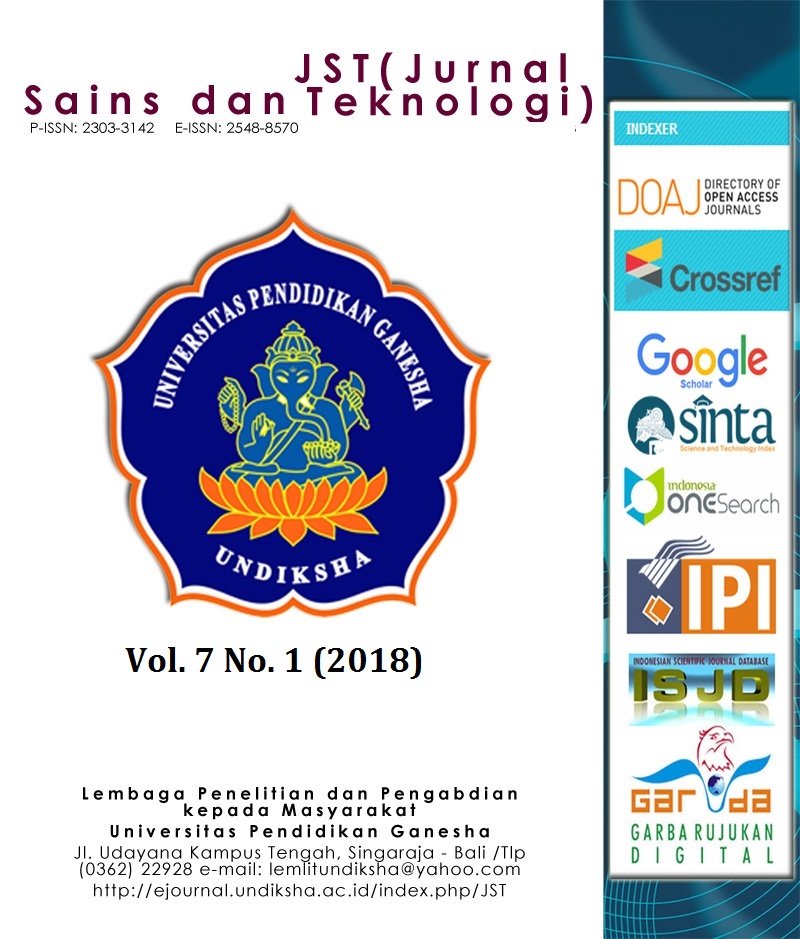AKTIVITAS ANTIBAKTERI EKSTRAK POLAR DAN NON POLAR BIJI KELOR (Moringa oleifera) ASAL PULAU TIMOR NTT
DOI:
https://doi.org/10.23887/jstundiksha.v7i1.13187Keywords:
Moringa oleifera, seed extracts, antibacterial activityAbstract
Tumbuhan kelor (Moringa oleifera) telah digunakan dalam pengobatan tradisional. Namun demikian belum diketahui aktivitas antibakteri ekstrak biji kelor asal pulau Timor NTT pada bakteri E.coli dan S.aureus. Ekstrak non polar didapatkan dengan metode maserasi menggunakan n-heksana yang kemudian diidentifikasi komponen kimianya dengan GC-MS. Ekstrak polar didapatkan dengan merebus biji kelor pada suhu 70oC menggunakan akuades. Dari hasil penelitian didapatkan bahwa kandungan terbesar pada ekstrak non-polar adalah asam oktadek-9-enoat (85,79%) yang adalah asam trans oleat dan asam-9-oktadekanoat (12,69%), suatu asam cis-oleat. Ekstrak polar pada konsentrasi optimum 100% memberikan daya hambat yang lebih besar yaitu 5,67 mm terhadap bakteri E. coli dan 7,33 mm terhadapS. aureus dibandingkan ekstrak non-polar yang memberikan daya hambat 4,67 mm terhadapE. coli dan 5,00 mm S. aureus. Disimpulkan bahwa ekstrak polar dan nonpolar biji kelor menunjukkan aktivitas antibakteri E.coli dan S.aureus. Perbedaan daya hambat didugakarena perbedaan pada kandungan senyawa kimianya.
References
Bukar, A., Uba, A., and Oyeyi, T.I., 2010, Antimikrobial Profile Moringa Oleifera Lam. Extracts Againts SomeFood-Borne Microorganisms, Bayero Journal of Pure and Applied Sciences, 3(1):43-48.
Vieira, G.H.F., Mourao, J.A., Angelo, A.M., Costa, R.A and Vieira, R.H., 2010, Antibacterial Effect (in vintro) Of Moringa oleifera and Annona muricata Against Garam Positive and Gram Negative Bacteria,Rev.Inst.Med.Trop.Sao Paulo, 53 (3):129-132
Goyal, B.R., Agrawal, B.B., Goyal, R.K., dan Mehta, A.A., 2007, Phyto-pharmacology of Moringa oleifera Lamk. ó An overview, Natural Product Radiance, Vol 6(4), pp 347-353.
Volk dan Wheeler, 1990, Mikrobiologi Dasar Edisi Kelima Jilid Dua, Erlangga:Jakarta.
Tally, F. P. 1993. Staphylococci: abscesses and other diseases. Dalam : Schaechter, M. (ed.) Mechanisms of MicrobialDiseases. 2nd Ed. Williams and Wilkins, USA. h. 187-197.
Suryawira, U., 1978, Mikroba Lingkungan. Edisi ke- 2, ITB: Bandung.
Eilert, U., Wolters, B., Nadrtedt, A., 1981, The Antibiotic Principle of seeds of Moringa oleifera and Moringa stenopetala, Planta Med, 42:55-61
Ragasa, C.Y., Levida, R.M., Don, M.J., dan Shen, C.C., 2012, Cytotoxic Isothiocyanates from Moringa oleifera Lam Seeds. Phillippine Science Letters 5(1):46-52
Oluduro, O.A., Idowu, T.O., Aderiye,B.I., Famurewa, O dan Omoboye,O.O., 2012, Evaluation of Antibacterial Potential of Crude Extract of Moringa oleifera seed on Orthopaedics Wound Isolates and Characterization ofPhenylmethanamine and Benzyl Isothiocyanate Derivatives. Research Journal of Medicinal Plant.1-12
Kalemba, D dan Kunicka, A., 2003, Antibacterial and antifungal properties of essential oils, Current Medicinal Chemistry, 10 (10): 813-829.
Mahmood, K.T., Mugal, T and Haq, I.U., 2010, Moringa a natural gift-A Reiview, J. Pham. Sci. & Re,Vol.2 (11), 775-781
Markam KR 1975. Isolation Techniques for Flavanoid. New York: The Flavanoids Academic Press.
Anwar, F., Sajid, Latid., Muhammad, Ashraf., dan Anwarul, Hassan.Gilani., 2007, Moringa oleifera: A Food Plant with Multiple Medicinal Uses. Phytotherapy Research, 21:17-25.
Bennet, R.N., Mellon, F.A., Foldi, N., et al. 2003, Profiling glucosinolates and phenolics in vegetative and reproductive tissues of the multi-purpose trees Moringa oleifera L (Horseradish tree) and Moringa stenopetala L. J Agric Food Chem, 51:3546-3553
Fahey, J.W., Zalcmann, A.T., Talalay, P., 2001, The chemical diversity and distribution of glucosinolates and isothiocyanates among plants, Phytochemistry, 56:5-51
Downloads
Published
How to Cite
Issue
Section
License
Authors who publish with the Jurnal Sains dan Teknologi (JST) agree to the following terms:
- Authors retain copyright and grant the journal the right of first publication with the work simultaneously licensed under a Creative Commons Attribution License (CC BY-SA 4.0) that allows others to share the work with an acknowledgment of the work's authorship and initial publication in this journal.
- Authors are able to enter into separate, additional contractual arrangements for the non-exclusive distribution of the journal's published version of the work (e.g., post it to an institutional repository or publish it in a book), with an acknowledgment of its initial publication in this journal.
- Authors are permitted and encouraged to post their work online (e.g., in institutional repositories or on their website) prior to and during the submission process, as it can lead to productive exchanges, as well as earlier and greater citation of published work. (See The Effect of Open Access)
















